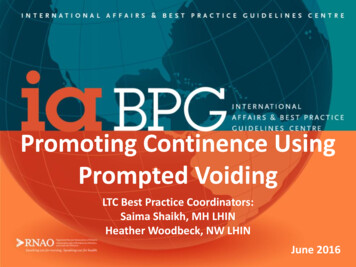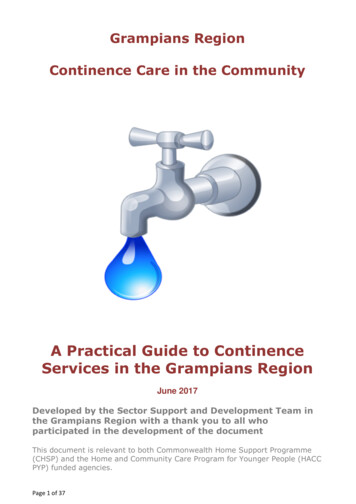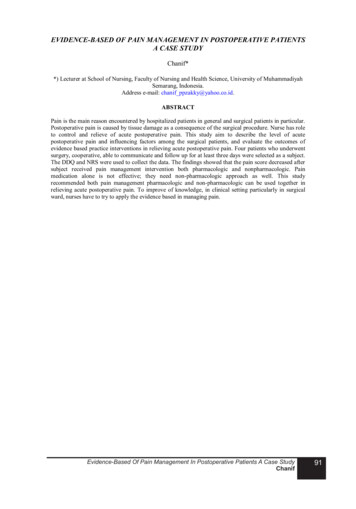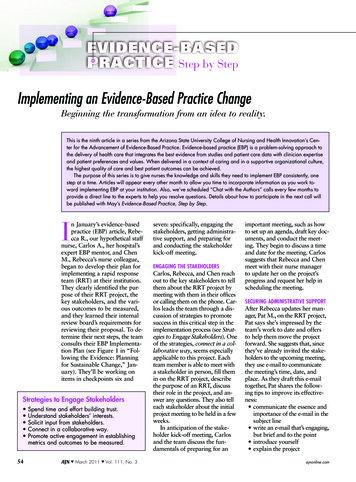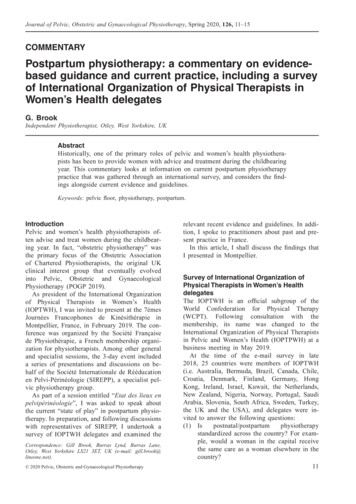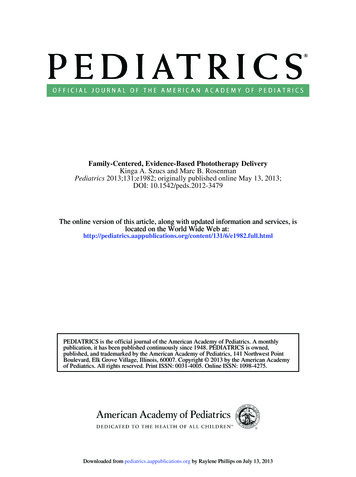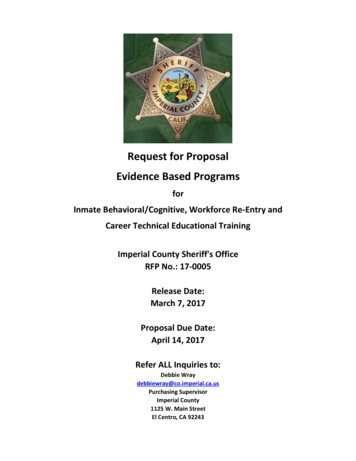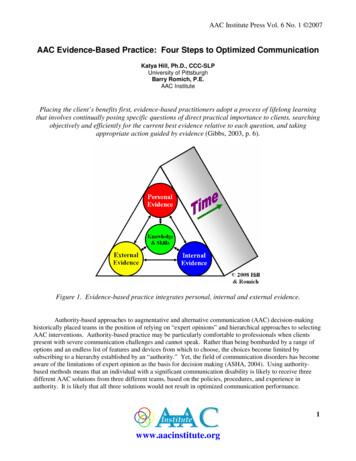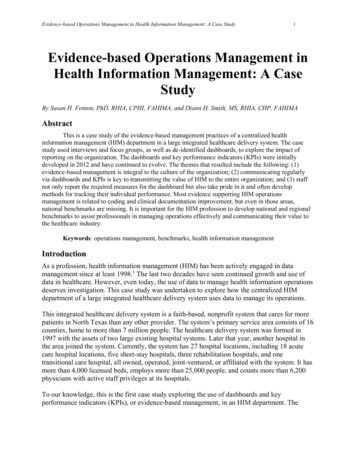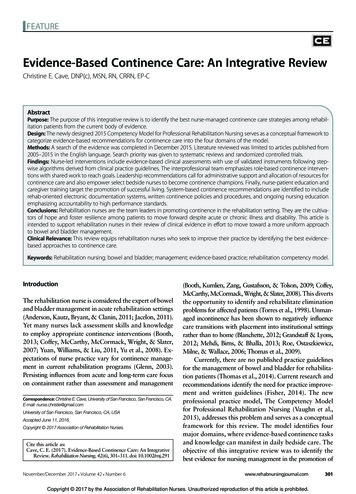
Transcription
FEATUREEvidence-Based Continence Care: An Integrative ReviewChristine E. Cave, DNP(c), MSN, RN, CRRN, EP-CAbstractPurpose: The purpose of this integrative review is to identify the best nurse-managed continence care strategies among rehabilitation patients from the current body of evidence.Design: The newly designed 2015 Competency Model for Professional Rehabilitation Nursing serves as a conceptual framework tocategorize evidence-based recommendations for continence care into the four domains of the model.Methods: A search of the evidence was completed in December 2015. Literature reviewed was limited to articles published from2005–2015 in the English language. Search priority was given to systematic reviews and randomized controlled trials.Findings: Nurse-led interventions include evidence-based clinical assessments with use of validated instruments following stepwise algorithms derived from clinical practice guidelines. The interprofessional team emphasizes role-based continence interventions with shared work to reach goals. Leadership recommendations call for administrative support and allocation of resources forcontinence care and also empower select bedside nurses to become continence champions. Finally, nurse-patient education andcaregiver training target the promotion of successful living. System-based continence recommendations are identified to includerehab-oriented electronic documentation systems, written continence policies and procedures, and ongoing nursing educationemphasizing accountability to high performance standards.Conclusions: Rehabilitation nurses are the team leaders in promoting continence in the rehabilitation setting. They are the cultivators of hope and foster resilience among patients to move forward despite acute or chronic illness and disability. This article isintended to support rehabilitation nurses in their review of clinical evidence in effort to move toward a more uniform approachto bowel and bladder management.Clinical Relevance: This review equips rehabilitation nurses who seek to improve their practice by identifying the best evidencebased approaches to continence care.Keywords: Rehabilitation nursing; bowel and bladder; management; evidence-based practice; rehabilitation competency model.IntroductionThe rehabilitation nurse is considered the expert of boweland bladder management in acute rehabilitation settings(Anderson, Kautz, Bryant, & Clanin, 2011; Jacelon, 2011).Yet many nurses lack assessment skills and knowledgeto employ appropriate continence interventions (Booth,2013; Coffey, McCarthy, McCormack, Wright, & Slater,2007; Yuan, Williams, & Liu, 2011, Yu et al., 2008). Expectations of nurse practice vary for continence management in current rehabilitation programs (Glenn, 2003).Persisting influences from acute and long-term care focuson containment rather than assessment and managementCorrespondence: Christine E. Cave, University of San Francisco, San Francisco, CA.E-mail: nurse.christie@gmail.comUniversity of San Francisco, San Francisco, CA, USAAccepted June 11, 2016.Copyright 2017 Association of Rehabilitation Nurses.Cite this article as:Cave, C. E. (2017). Evidence-Based Continence Care: An IntegrativeReview. Rehabilitation Nursing, 42(6), 301–311. doi: 10.1002/rnj.291November/December 2017 Volume 42 Number 6(Booth, Kumlien, Zang, Gustafsson, & Tolson, 2009; Coffey,McCarthy, McCormack, Wright, & Slater, 2008). This divertsthe opportunity to identify and rehabilitate eliminationproblems for affected patients (Torres et al., 1998). Unmanaged incontinence has been shown to negatively influencecare transitions with placement into institutional settingsrather than to home (Blanchette, 2012; Grandstaff & Lyons,2012; Mehdi, Birns, & Bhalla, 2013; Roe, Ostaszkiewicz,Milne, & Wallace, 2006; Thomas et al., 2009).Currently, there are no published practice guidelinesfor the management of bowel and bladder for rehabilitation patients (Thomas et al., 2014). Current research andrecommendations identify the need for practice improvement and written guidelines (Fisher, 2014). The newprofessional practice model, The Competency Modelfor Professional Rehabilitation Nursing (Vaughn et al.,2015), addresses this problem and serves as a conceptualframework for this review. The model identifies fourmajor domains, where evidence-based continence tasksand knowledge can manifest in daily bedside care. Theobjective of this integrative review was to identify thebest evidence for nursing management in the promotion ofwww.rehabnursingjournal.comCopyright 2017 by the Association of Rehabilitation Nurses. Unauthorized reproduction of this article is prohibited.301
302Evidence-Based Continence Care: An Integrative Reviewbowel and bladder continence to improve rehabilitationcare practices. Target audiences include practicing bedside nurses, rehabilitation program leaders, and rehabilitation nurse researchers.Literature Search StrategyRegulations and standards for bowel and bladder management exist in the literature for long-term care, butnot for acute care settings, including acute rehabilitation(Newman & Wein, 2009). Although bowel and bladdermanagement objectives are identified in the core curriculum for rehabilitation nurses (Jacelon, 2011), no resource publication exists. The purpose of this literaturereview was to collect relevant evidence where continenceimprovements were achieved by nursing and/or careteam interventions.A search of the evidence was completed in December2015. Literature reviewed was limited to articles published from 2005 to 2015 in the English language. Searchpriority was given to systematic reviews and randomizedcontrolled trials (RCTs). Expert opinions of publishedarticles exploring evidence-based practice in a postacutesetting were also reviewed. A search of the CINAHLand PubMed databases included the following termsand MeSH headings, separated by the Boolean operator“OR”: bowel management, bladder management, incontinence, constipation, fecal incontinence, and bladdertraining. The resulting list was then searched with theBoolean operator “AND” with the following neurologicconditions 2 separated by the Boolean operator “OR”:stroke, spinal cord injury, Parkinson’s disease, multiplesclerosis, brain injury. This search had a total yield of602 articles. Studies published in peer-reviewed journalsthat investigated continence or bowel regularity after implementing at least one nurse-led intervention among rehabilitation or neurological patients in both inpatient oroutpatient settings were included. A total of 21 systematicreviews and 11 RCTs, three quasi-experimental studies,and 20 mixed-method quantitative studies were found.The Johns Hopkins Evidence-Based Practice ResearchEvidence Appraisal Tool (2013) was used to evaluateall systematic reviews and RCTs for quality and level ofevidence. Twenty-three empirical publications were evaluated using the Rapid Critical Appraisal of EvidenceBased Practice Implementation or Quality ImprovementProjects (Melnyk & Fineout-Overholt, 2015).A second literature search was conducted to identifyclinical practice guidelines (CPGs) published within thesame time frame and also in the English language. Published standards or practice guidelines were also includedfrom national and international organizations on thetopic of bowel or bladder continence. This web-basedC. E. Cavesearch yielded a total of 16 publications for urinarymanagement and 10 publications for bowel management.Clinical practice guidelines were reviewed for interventions that may be performed by a nurse or rehabilitationteam in a clinical setting. All CPGs were evaluated usingthe AGREE II Instrument tool (AGREE, 2009).Conceptual FrameworkVaughn et al. (2015) created a competency model for theprofessional rehabilitation nurse wherein skills and knowledge are progressively developed through practicebasedlearning and professional development. The rehabilitation competency model can be utilized as a frameworkfor a nurse-centric evidence-based continence approachfor bowel and bladder management for rehabilitationpatients. The four domains identified in the model include:nurse-led interventions, leadership, interprofessional care,and promotion of successful living. Continence carerequires specialized knowledge and care managementthat can be categorized into these four domains. Here,the structure of the model provides a methodology forknowledge, skills, and care-coordination required forpatient continence. The nurse is presented as a lead decision maker in the implementation of evidencebasedcontinence strategies. (See Appendix A for the adaptationof the competency model for the work of evidence-basedcontinence care.)Domain 1: Nurse-Led InterventionsUnderstand PathophysiologyRehabilitation nurses must manage a broad spectrum ofpatients requiring unique approaches to achieve the goalof continence. Studies conducted in long-term and acutecare environments have found that nursing staff and interprofessional teams lack a comprehensive physiological understanding of normal controls of micturition anddefecation (Coffey et al., 2007; DuBeau, Kuchel, Johnson,Palmer, & Wagg, 2010; Mehdi et al., 2013; Schnelle et al.,2010). Without a scientific appreciation for the underlying pathologies of incontinence, nurses may unknowinglyapply inappropriate interventions accompanied by ambivalence and mismanagement (Dingwall & Mclafferty, 2006).Rehabilitation nurses must understand the etiologiesbehind elimination disturbance to effectively correct it(King & Pilcher, 2008; Ostaszkiewicz, O’Connell, &Miller, 2008). Such knowledge begins with an appreciation of the central and peripheral nervous systems andthe intricate autonomic control mechanisms for boweland bladder continence (Gray, 2006; Heitkemper,2006; Kaplan et al., 2013). Nurses must identify riskCopyright 2017 by the Association of Rehabilitation Nurses. Unauthorized reproduction of this article is prohibited.
www.rehabnursingjournal.comNovember/December 2017 Volume 42 Number 6factors and comorbidities that exacerbate urinary orgastrointestinal dysfunction such as neurological conditions, medication side effects, pain, cognitive impairment, etc. (DuBeau et al., 2010). Disruption of normalbowel and bladder patterns caused by acute injury andchronic disease should be identified using appropriateclinical terminology (Doughty & Jensen, 2006).Evidence-based AssessmentsPatient problem identification requires a thoroughand skilled assessment of bowel and bladder together(Cameron et al., 2015; Chipps, 2011; Kaplan et al., 2013;Ostaszkiewicz, Ski, & Hornby, 2005; Tod, Stringer,Levery, Dean, & Brown, 2007). Systematic evaluation(structured interviews with physical assessments) performedby nurses and care teams have shown positive results foridentifying various forms of urinary continence (Coffeyet al., 2008; Cournan, 2012; Glenn, 2003; Herr-Wilbert,Imhof, Hund-Georgiadis, & Wilbert, 2010; King & Pilcher,2008; Torres et al., 1998). In a study conducted by HerrWilbert et al. (2010), physiology-based bladder assessmentalgorithm improved the identification of specific forms ofincontinence (urge incontinence, neurogenic bladder andretention, or functional incontinence). Evidence-basedbowel assessments include establishing the patient’spremorbid bowel history, previous and current use oflaxatives, last bowel movement date and consistency,and a physical pelvic, abdominal, and rectal examination(Doughty & Jensen, 2006).Validated screening tools and instruments can improve assessments and identify barriers to correcting dysfunction (urinary or fecal incontinence and constipation).They can also add value to rehabilitation programs whencomparing outcomes of continence interventions afterspecific measures of time. Specific tools have been usedto identify urinary continence problems among rehabilitation patients with the Urogenital Distress Inventory 6, the Neurological Disability Scale, the AmericanUrological Association Symptom Index, and the Incontinence Impact Questionnaire 7 (Dowling-Castronovo &Bradway, 2012; Khan, Pallant, Brand, & Kilpatrick,2015). Tools to identify problems and level-of-bother frombowel dysfunction include the Self-report Fecal Incontinenceand Constipation Questionnaire (Wang, Deutscher, Yen,Werneke, & Mioduski, 2014); the Constipation RiskAssessment Scale (Richmond & Wright, 2006); theGastrointestinal Symptom Severity Index (Crowell et al.,2015), and the Fecal Incontinence Severity Index (Cameronet al., 2015). As recommended from the literature, use ofvalidated instruments should be further researched forvalidity in acute rehabilitation populations.303Care AlgorithmsDecision aids and algorithms can assist nursing staffthrough procedural assessments to plan interventionsaccordingly. Clinical practice guidelines such as thosefrom the Agency for Healthcare Research and Quality(AHRQ, 2009) and the Association of RehabilitationNurses (Folden et al., 2002) establish standardized nursing tasks during assessments and interventions designedto optimize continence outcomes. Algorithms providestructure to guide competent, functional knowledge ofthe genitourinary and gastroenteric systems (Kaplan et al.,2013). Implementation of pathology-guided algorithmsfor systematic assessment and intervention-design areuseful for guiding new or experienced nurses in rehabilitation practice (DuBeau et al., 2010). These care algorithms can inform the strategic documentation neededto evaluate effective continence care. (See Appendix B foran example of an evidence-based algorithm for boweland bladder management.)Evidence-based Bladder InterventionsThe aim of a RCT conducted by Khan et al. (2015) was toevaluate the effect of individualized treatments to improveurinary symptoms for patients with multiple sclerosis.Initial treatment began with a urinalysis to screen forinfection. Bladder patterns were closely tracked in patients of the treatment group using a 3-day voidingand
2015), and the Fecal Incontinence Severity Index (Cameron et al., 2015). As recommended from the literature, use of validated instruments should be further researched for validity in acute rehabilitation populations. Care Algorithms Decision aids and algorithms can assist nursing staff through procedural assessments to plan interventions .

